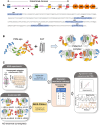Conformational dynamics and multimodal interaction of Paxillin with the focal adhesion targeting domain
- PMID: 40532016
- PMCID: PMC12175908
- DOI: 10.1126/sciadv.adt9936
Conformational dynamics and multimodal interaction of Paxillin with the focal adhesion targeting domain
Abstract
Paxillin (PXN) and focal adhesion kinase (FAK) are two major components of the focal adhesion complex, a multiprotein structure linking the intracellular cytoskeleton to the cell exterior. The interaction between the disordered amino-terminal domain of PXN and the carboxyl-terminal targeting domain of FAK (FAT) is necessary and sufficient for localizing FAK to focal adhesions. Furthermore, PXN serves as a platform for recruiting other proteins that together control the dynamic changes needed for cell migration and survival. Here, we show that the PXN N-domain undergoes significant compaction upon FAT binding, forming a 48-kilodalton multimodal complex with four major interconverting states. Although the complex is flexible, each state has unique sets of contacts involving disordered regions that are both highly represented in ensembles and conserved. PXN being a hub protein, the results provide a structural basis for understanding how shifts in the multistate equilibrium (e.g., through ligand binding and phosphorylation) may rewire cellular networks leading to phenotypic changes.
Figures










Update of
-
Conformational dynamics and multi-modal interaction of Paxillin with the Focal Adhesion Targeting Domain.bioRxiv [Preprint]. 2025 May 14:2025.01.01.630265. doi: 10.1101/2025.01.01.630265. bioRxiv. 2025. Update in: Sci Adv. 2025 Jun 20;11(25):eadt9936. doi: 10.1126/sciadv.adt9936. PMID: 39803547 Free PMC article. Updated. Preprint.
References
-
- Chen C. S., Alonso J. L., Ostuni E., Whitesides G. M., Ingber D. E., Cell shape provides global control of focal adhesion assembly. Biochem. Biophys. Res. Commun. 307, 355–361 (2003). - PubMed
-
- Parsons J. T., Martin K. H., Slack J. K., Taylor J. M., Weed S. A., Focal adhesion kinase: A regulator of focal adhesion dynamics and cell movement. Oncogene 19, 5606–5613 (2000). - PubMed
MeSH terms
Substances
Grants and funding
LinkOut - more resources
Full Text Sources
Miscellaneous

